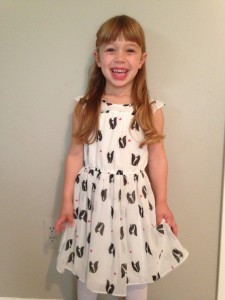I get a lot of questions about how we can teach the things I write about to young children. 
Raising children who see the truth about their nature, who are comfortable with emotion, and who know how their experience is created, is a big deal. It’s no exaggeration to say that this understanding could change the world.
The thing is, children already know this stuff. They intuitively, instinctively get it.
We’re all born with this understanding. It is in our factory default settings. We simply program over it as we grow up, as we learn to take our thinking seriously and we come to question our innate nature. The simple truth gets forgotten and a bit buried.
The best thing we as parents, aunts, uncles, and teachers can do for the children around us is to remember ourselves.
As soon as we live the truth, seeing ourselves and the people around us as innately healthy and well regardless of the state of their life (which is only a reflection of their state of mind), the kids around us will be that much closer to what they already know.
As soon as we adults become more honest and more emotional—when we stop fearing or judging our own emotions—the children around us will effortlessly do the same.
That said, as children get older and more exposed to the outside-in-looking world around them, you may want to talk to them about these things.
I want to.
***
Willow will be 5 years old in a few weeks.
For the past couple of months, I’ve been casually talking with her about two primary things. The first is that she is always well and mentally healthy by nature—that’s true for all people, all of the time., no exceptions.
Basically, I remind her that when her mind quiets down, she experiences a nice, peaceful feeling. That feeling is her home base .
But I say it in 4 year old terms. Something like… “You know when you’re relaxed or feeling really peaceful, like maybe right before you fall asleep? There is a nice feeling you feel in your heart…do you know what I mean? You know what’s really cool? That feeling is always there, and always will be there your whole life. Even when you’re 100! When your mind settles down you will be able to feel it.”
The first time I said something like that, she smiled, put her hands over her heart, closed her eyes, and said “I know that already…I can feel it right now!”
It was not a tough conversation to have. I taught her nothing she didn’t already know.
I’ve also talked to her about the fact that her mind can get very busy and crowded and that when it does, she may not feel her best. She’s always feeling her thoughts, not what’s happening around her, and if she doesn’t like what her thoughts are giving her she can wait until something better comes along.
In 4 year old language, it’s all about bubbles. Something like…”Do you know that all people get millions of thoughts floating around in their heads every single day? Those thoughts are sort of like bubbles… they float around a bit and are interesting to notice, and then they pop. Some bubbles pop faster than others, but they all pop at some point. So if you ever have thoughts in your head that don’t feel that good to you, just wait. They will pop and then you’ll feel different.”
We’ve talked a bit about how we don’t need to pay attention to every single bubble in our head. How if she’s feeling angry, for example, that’s because she has a lot of angry “bubbles” floating around, but that it’s not a problem because those angry bubbles will pop and she’ll get new bubbles.
A couple weeks after our initial bubbles conversations, she casually said these things:
Talking about a kid at preschool: “Trevor gets in trouble all the time. He has a lot of thoughts to be bad, and I guess he just likes to listen to them.”
Talking about her rambunctious little brother: “Miller does whatever his head tells him to, that’s why he runs around so crazy all of the time.”
Talking about her Dad who was screaming about the Green Bay Packer’s poor performance during a game: “Angry bubbles!” (as she walked away shaking her head).
Sharing these truths with children is the easiest thing you can do because your audience already knows everything you’re saying. They are closer to it, and maybe remember it better than you do.
But remember, the most effective way to help them remember is for you to remember. When you live it without needing to talk about it often, their wisdom will help them fall right into it.
P.S.–this was written for you. And your children, by extension, but really for you. Even though you’re older than 4 and incredibly intelligent, it’s okay if you want to think of your thoughts as bubbles, or feel that peaceful home base as you’re falling asleep. It’ll be our little secret.





